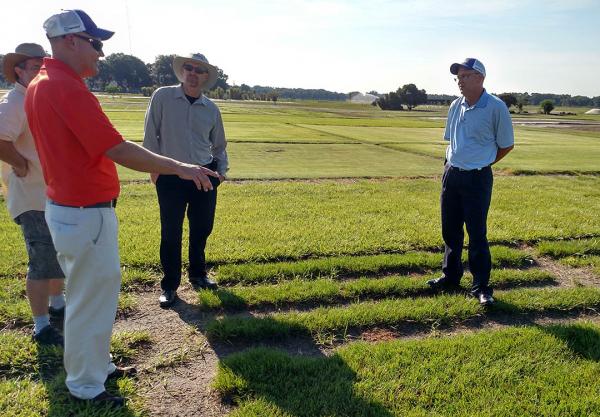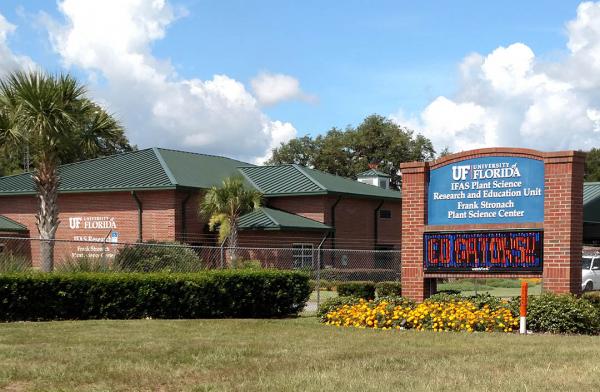Presenting a unified front is easier said than done for the disparate parts that together comprise the University of Florida turfgrass management program (@UFTurfTeam). A slew of challenges confront the program, not the least of which are of a geographic nature.
 "Our turf faculty is spread across four geographic locations and eight academic departments," said Bryan Unruh, Ph.D., professor of environmental horticulture and associate center director for the university's West Florida Research and Education Center.
"Our turf faculty is spread across four geographic locations and eight academic departments," said Bryan Unruh, Ph.D., professor of environmental horticulture and associate center director for the university's West Florida Research and Education Center.Located in the Panhandle city of Jay, the research center is 340 miles west of the main campus in Gainesville and the nearby turf research center in Citra, and is 640 miles from the Fort Lauderdale Research and Education Center in South Florida.
"I don't know of another research facility in a subtropical climate," said Travis Shaddox, Ph.D., assistant professor of turfgrass management who is based in the Fort Lauderdale facility. "The turf never stops growing. It slows down in December and January, but it never stops growing, so weed challenges are different and disease challenges are different."
Historically, Florida's width and breadth alone - it is 830 miles from Pensacola to Key West - has made servicing the needs of various stakeholders around the state a monumental challenge. Throw in the climatological differences from one end to the other as well as the sheer number of people needing help - there are 75,000 fertilizer applicators in Florida - one might think it would require a small army to be everywhere at once. Instead, all it has taken is a little planning and a refocused team effort.
"Other places have their challenges as well. Part of ours is that we have a lot of distance between research centers, a lot of environmental changes and a tremendous amount of clientele. The population is going up all the time," Shaddox said. "Then you have to consider how much turfgrass there is in Florida. There is a tremendous amount of golf courses, sod farms and lawn care operators. It's always a challenge.
"We are all in our own little world, but we have to take a step back realize this is Florida, not just Fort Lauderdale, or Jay or Citra. We have to address all of the needs of people all around the state."
Unruh agreed.
"We are trying to move forward with a unified message about turf in Florida, rather than turfgrass in South Florida or turfgrass in North Florida," Unruh said. "We're the same institution, and we're trying to be more understanding that there is greater value in an all-encompassing message even though there are environmental differences between locations. People in North Florida and South Florida manage turf differently, but the University of Florida is the whole state."
Faculty are spread across four facilities - the main campus in Gainesville, Fort Lauderdale, the Milton campus near Jay and another facility in Belle Glade. In all, the university has 13 research stations across the state, many of which are agricultural research posts. In the past, the turf program had difficulty covering Florida's 65,755 square miles, largely because it's just so darned far from one end of the state to the other. In those early days some 20 years ago, Unruh met with some of Florida's golf course superintendents to learn what the university could do to improve its relationship with those who needed its help.
"The perception was that the university had been acting in a vacuum," said Darren Davis, CGCS of Olde Florida Golf Club in Naples, who was among that group with whom Unruh met. "Bryan has increased the communication between the university and the golf course superintendents in the state, enabling himself to be more of a conduit between the university and superintendents."
Although much of the UF effort centers around traditional education and extension services, the turf team is looking for other ways to help educate those in the turf industry. For example, an upcoming turf school short course entitled the Evidence-Based Turf Management Short Course at the Fort Lauderdale facility. The event will focus on fertility and water needs and is designed to appeal to professional turf managers as well as homeowners and everyone in between.
"We have to make sure we dont slant education to be just for superintendents," Unruh said. "We have to make sure that the cookies are at a level where everyone can eat them."
Getting the entire turf team on the same page has been an ongoing process since the mid 1990s, which, coincidentally, is when Unruh came on board. With some researchers retiring and new ones taking their place, the time had come this spring, he said, for everyone to convene again.
To that end, Unruh, who has been at UF since 1996, hosted the entire turf team in April to reaffirm that focus and introduce its recent hires in Shaddox and entomologist Adam Dale, Ph.D.
 "The team really came together, and we're thinking much more strategically now," Unruh said. "How do we better serve the state?
"The team really came together, and we're thinking much more strategically now," Unruh said. "How do we better serve the state?"We knew what we did was so discombobulated. The people around the state know Bryan Unruh, but the turf team as a whole is not known around the state as a center of influence."
Part of presenting that united front also means supporting the efforts of colleagues for all-important research funding. Unruh recently attended a Florida GCSA meeting to stump for research funding. But he didn't just ask for funding for his own projects, he also spoke on behalf of three other projects that were not his.
"Adam Dale is the new guy. He's the rookie," Unruh said. "We need to prioritize his funding needs of the old guys because he has to get tenured promotion, and I think it is incumbent on the old guys to make sure that happens."
For the record, Unruh considers himself one of those "old" guys. His appointment is 70 percent extension, and he has the frequent flyer miles to prove it. However, given the challenges of getting around Florida and the unique needs of turf managers throughout the state, it is not uncommon for Shaddox or Jason Kruse, Ph.D., who is at the main campus in Gainesville, to pull some outreach duty as well.
"Through May, I was gone every week of the year except two. I used to add up (travel), but it got depressing, so I stopped doing it," Unruh joked.
His efforts and those of his colleagues to better serve the needs of superintendents, sports turf managers, lawn care operators and private residents around the state are no laughing matter.
"Bryan, since he's come in, has gone to bat for us," Davis said. "Professors and researchers are like superintendents; some are introverts. Bryan has helped connect the two groups by being visible and communicating the needs of all of the university, not just himself. He has become a face for the university."

